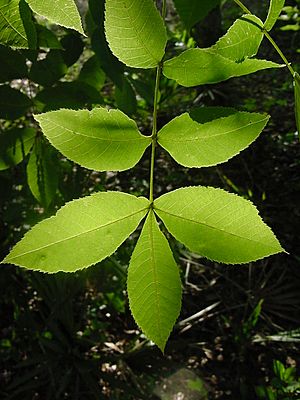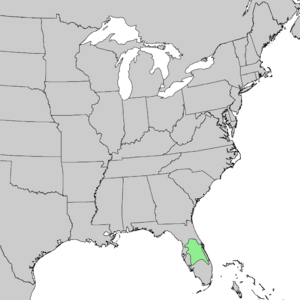Scrub hickory facts for kids
Quick facts for kids Scrub hickory |
|
|---|---|
 |
|
| Compound leaf of the scrub hickory | |
| Scientific classification | |
| Genus: |
Carya
|
| Species: |
floridana
|
 |
|
| Natural range of Carya floridana | |
The scrub hickory (also known as Carya floridana) is a special type of tree. It grows only in central Florida in the Southern United States. This means it is endemic to that area, found nowhere else naturally.
Even though some scrub hickories can grow as tall as 25 meters (about 80 feet), many are smaller. They often look like large shrubs, only 3 to 5 meters tall. These smaller trees have many thin trunks. Their leaves are long, about 20 to 30 centimeters. Each leaf has three to seven smaller parts called leaflets. These leaflets are 4 to 10 centimeters long and have rough, jagged edges. The tree also grows a fruit that is a nut. This nut is about 3 to 4 centimeters long and 2 to 2.5 centimeters wide. It has a thick, hard shell. Inside, there is a sweet, edible seed.
Contents
Where Scrub Hickories Grow
The scrub hickory is found only in central Florida. It is a unique part of the plant life in that region.
Related Hickory Trees
The scrub hickory is similar to another tree called the black hickory (Carya texana). However, these two trees grow in different places. The scrub hickory also shares some features with the pignut hickory (Carya glabra). Where their growing areas meet, they can sometimes mix their traits.
Life Cycle and Growth
For a scrub hickory seed to start growing, it needs a special process called stratification. This means the seeds need to go through a period of cold and moisture. This process helps the seed break its dormancy and begin to sprout.
Tree Genetics
Scientists study the genetics of plants to understand them better. The scrub hickory is known to be a "64-chromosome species." This means that each cell in the scrub hickory tree has 64 chromosomes. Chromosomes are tiny structures inside cells that carry all the genetic information, like a blueprint for the tree.
See also
 In Spanish: Carya floridana para niños
In Spanish: Carya floridana para niños

